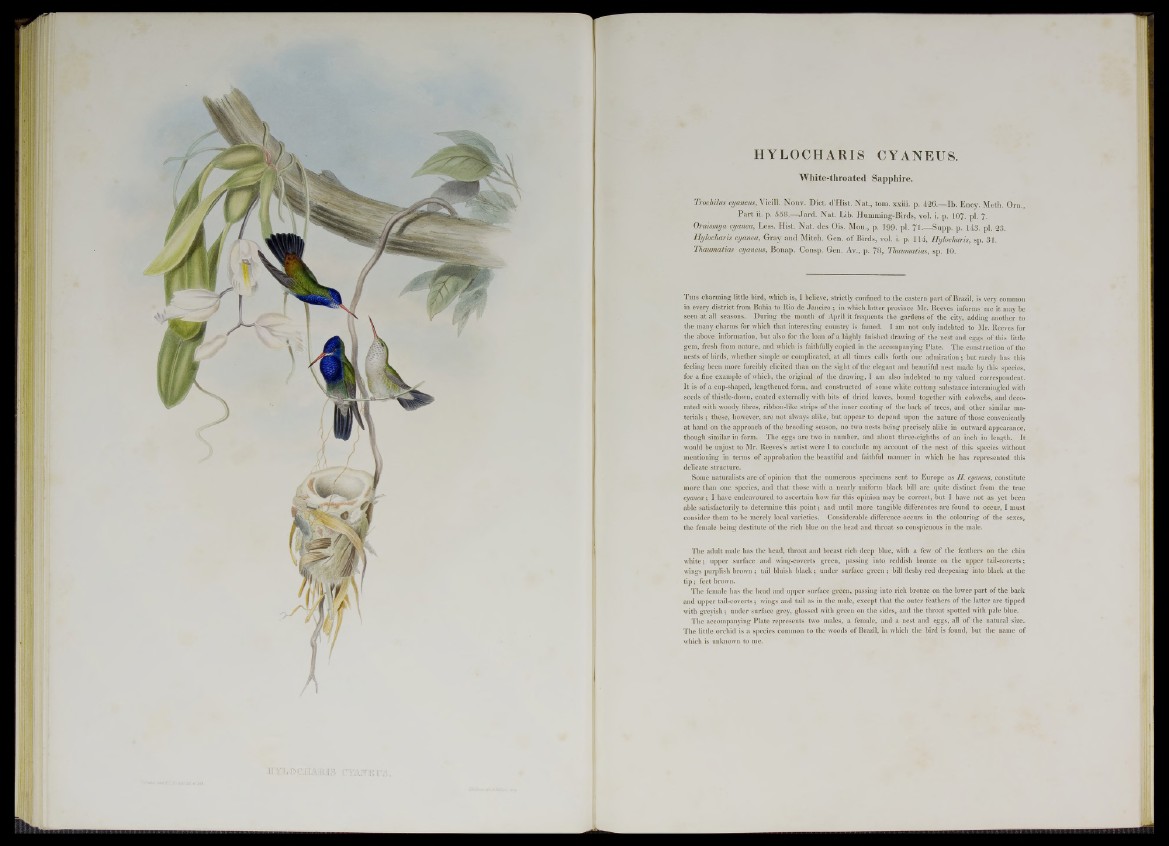
HYLOCHARI S CYANEUS.
White-throated Sapphire.
Trochilus cyaneus, Vieill. Nouv. Diet. d’Hist. Nat., tom. xxiii. p. 426.— lb . Ency. Meth. Orn.,
P a r t ii. p. 558.—J a rd . Nat. Lib. Humming-Birds, vol. i. p. 107. pi. 7-
Ornismya cyanea, Less. Hist. N a t. des Ois. Mou., p. 199. pi. 71.— Supp. p. 143. pi. 23.
Hylocharis cyanea, Gray and Mitch. Gen. of Birds, vol. i. p. 114, Hylocharis, sp. 31.
Thaumatias cyaneus, Bonap. Consp. Gen. Av., p. 78, Thaumatias, sp. 10.
T h i s charming little bird, which is, I believe, strictly confined to the eastern part of Brazil, is very common
in every district from Bahia to Rio de Janeiro ; in which latter province Mr. Reeves informs me it may be
seen at all seasons. During the month of April it frequents the gardens of the city, adding another to
the many charms for which that interesting country is famed. I am not only indebted to Mr. Reeves for
the above information, but also for the loan of a highly finished drawing of the nest and eggs of this little
gem, fresh from nature, and which is faithfully copied in the accompanying Plate. The construction of the
nests of birds, whether simple or complicated, at all times calls forth our admiration; but rarely has this
feeling been more forcibly elicited than on the sight of the elegant and beautiful nest made by this species,
for a fine example of which, the original of the drawing, I am also indebted to my valued correspondent.
It is of a cup-shaped, lengthened form, and constructed of some white cottony substance intermingled with
seeds of thistle-down, coated externally with bits of dried leaves, bound together with cobwebs, and decorated
with woody fibres, ribbon-like strips of the inner coating of the bark of trees, and other similar materials
; these, however, are not always alike, but appear to depend upon the nature of those conveniently
at hand on the approach of the breeding season, no two nests being precisely alike in outward appearance,
though similar in form. The eggs are two in number, and about tbree-eigbths of an inch in length. It
would be unjust to Mr. Reeves’s artist were I to conclude my account of the nest of this species without
mentioning in terms of approbation the beautiful and faithful manner in which he has represented this
delicate structure.
Some naturalists are of opinion that the numerous specimens sent to Europe as H cyaneus, constitute
more than one species, and that those with a nearly uniform black bill are quite distinct from the true
cyanea; I have endeavoured to ascertain how far this opinion may be correct, but I have not as yet been
able satisfactorily to determine this point; and until more tangible differences are found to occur, I must
consider them to be merely local varieties. Considerable difference occurs in the colouring of the sexes,
the female being destitute of the rich blue on the head and throat so conspicuous in the male.
The adult male has the head, throat and breast rich deep blue, with a few of the feathers on the chin
white; upper surface and wing-coverts green, passing into reddish bronze on the upper tail-coverts;
wings purplish brown ; tail bluish black; under surface green ; bill fleshy red deepening into black at the
tip ; feet brown.
The female has the head and upper surface green, passing into rich bronze on the lower part of the back
and upper tail-coverts; wings and tail as in the male, except that the outer feathers of the latter are tipped
with greyish; under surface grey, glossed with green on the sides, and the throat spotted with pale blue.
The accompanying Plate represents two males, a female, and a nest and eggs, all of the natural size.
The little orchid is a species common to the woods of Brazil, in which the bird is found, but the name of
which is unknown to me.